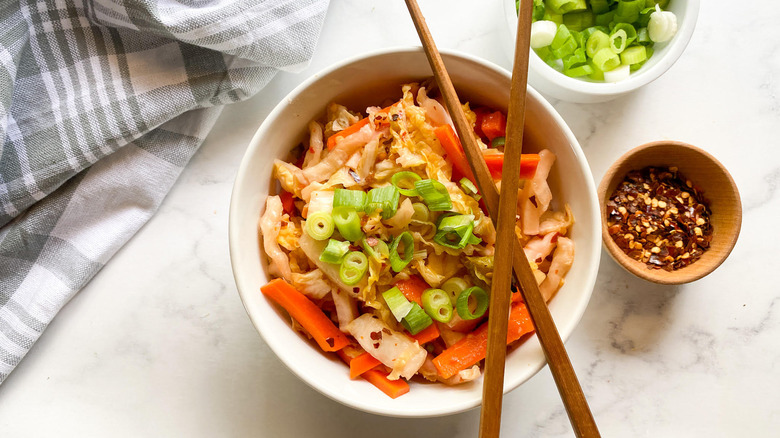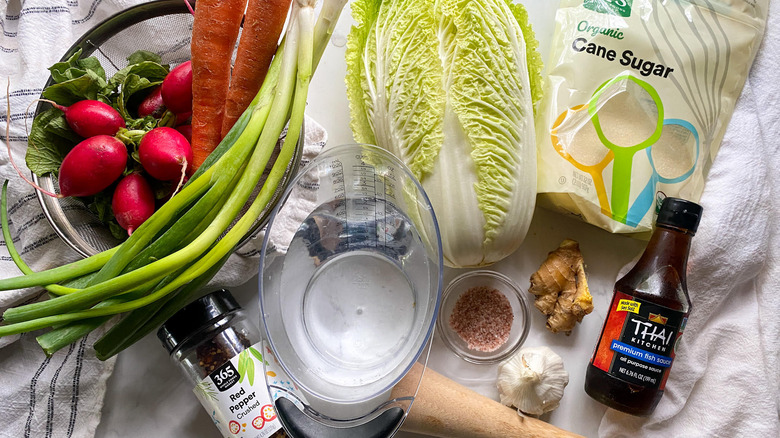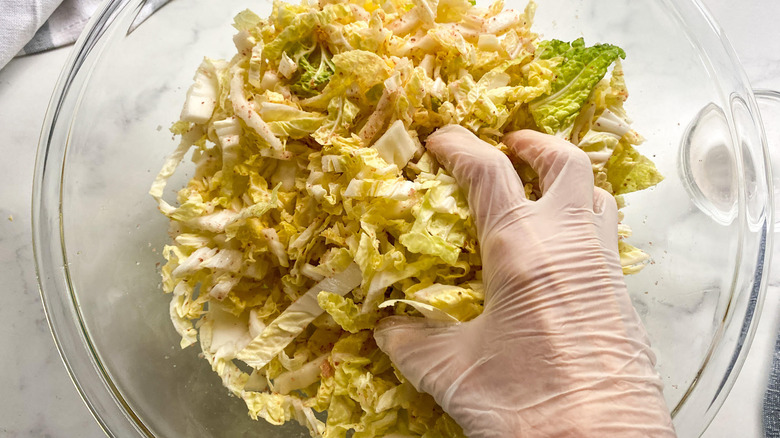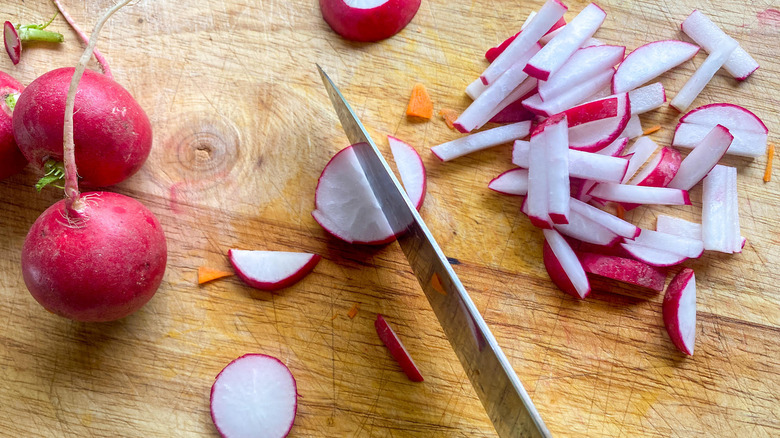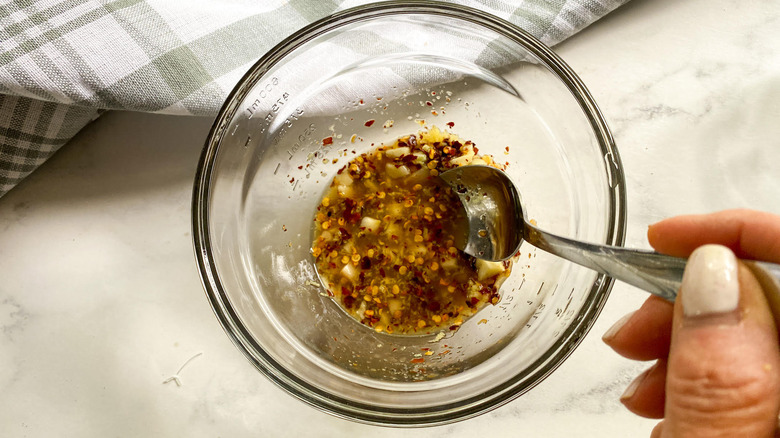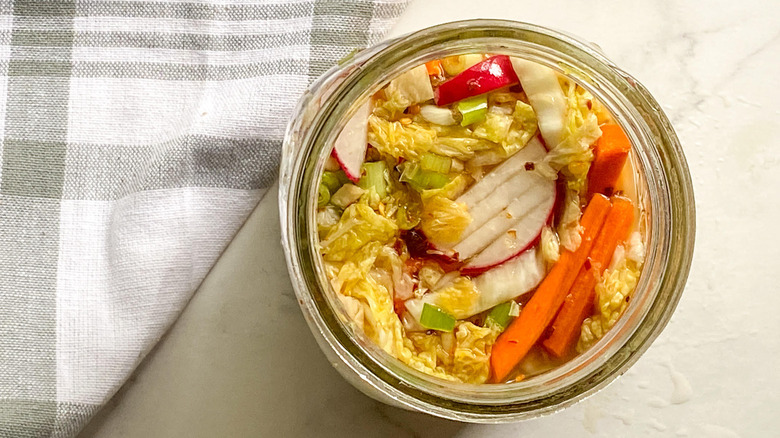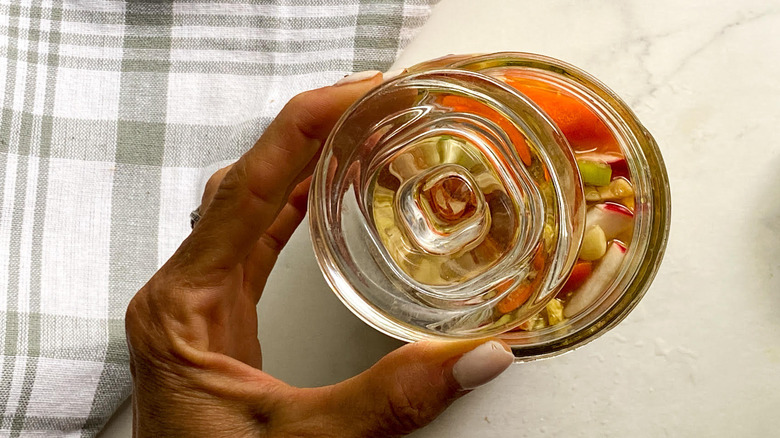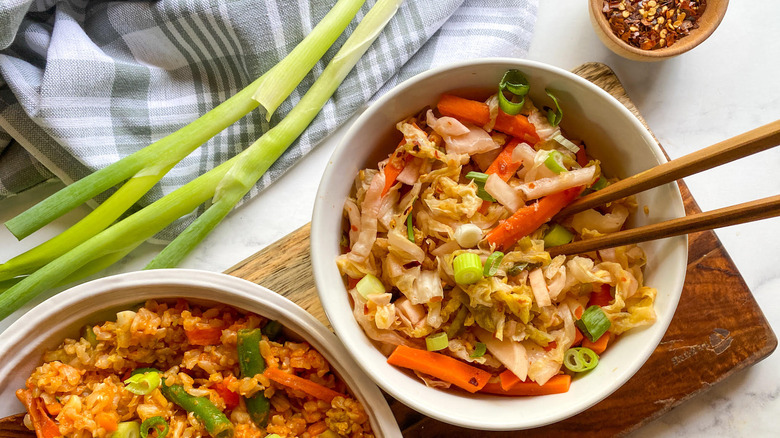Classic Homemade Kimchi Recipe
Prep Time: 1h 10m
Cook Time:
Yield: 10 Servings
Ingredients
- 1 medium head Napa cabbage
- 3 tablespoons pink Himalayan salt
- 5 cups filtered water
- 2 carrots, cut into matchsticks
- 5 radishes, cut into matchsticks
- 4 scallions, chopped
- 1 tablespoon ginger, grated
- 4 cloves garlic, minced
- 3 tablespoons fish sauce
- 1 tablespoon red pepper flakes
- 1 tablespoon sugar
Directions
- Cut the cabbage in half lengthwise, then again into quarters. Remove the core, then cut it crosswise into thin strips.
- Place the cabbage in a large bowl and add the salt. With a gloved hand, massage the salt into the cabbage so it's fully distributed.
- Cover the cabbage with filtered water and place a plate on top of the vegetable to keep it submerged under the water. Let this sit for an hour
- While the cabbage is sitting, prep the carrots, radishes, scallions, ginger, and garlic.
- In a small bowl, combine the ginger, garlic, fish sauce (or water, if preferred), red pepper flakes, and sugar.
- When the cabbage is ready, drain the water it was in, and rinse it in fresh water. Put it back in the large bowl.
- Add the carrots, radishes, scallions, and sauce. Mix well with a gloved hand to fully combine.
- Add this to a 32-ounce Mason jar. As you fill the jar, press down on the kimchi with a wooden mallet to enable the liquid to rise above the cabbage mixture to remove any air pockets. Continue filling the jar and pressing out the air until you've added all the cabbage and the jar is almost full. You want to maintain a ½-1-inch space at the top empty. There should be a layer of liquid covering the cabbage and rising above it.
- If you have one, place a glass weight (made for this purpose) on top of the kimchi to keep the vegetables below the surface of the liquid. If you don't have a glass weight, use a large piece of cabbage to fold over the mixture to keep it from rising above the water.
- Close the lid tightly. If you don't have a lid designed for fermenting, you can use a wide-mouth plastic lid and leave more empty space at the top to account for escaping gas.
- Let the jar sit on the counter for 3-14 days. Once it's ready to go (taste it to see if you like it before storing in the fridge), store it in the fridge with a lid for up to a month.
Gather the ingredients for this easy homemade Kimchi
Kimchi has been around for ages; and when we say ages, we really mean it. According to BBC, kimchi dates back about 3,000 years. Originating in Korea, this tasty topping was initially made to preserve and store vegetables over the cold winter months — a time when many Koreans died of starvation. Talk about being resourceful!
There are plenty of ways to enjoy kimchi, including as a topping on rice, in a stew, or eaten plain. Recipe developer Miriam Hahn explains exactly what kimchi is and why we should all be eating it. "Kimchi is a traditional Korean dish and is the Korean version of sauerkraut. In Korea, they eat a small portion with every meal because it is helpful with digestion," Hahn explains. "There are a lot of versions [of kimchi], but almost all of them contain cabbage, carrots, garlic, and ginger. It usually has quite a kick, but one of the nice things about making it from home is you can control the heat." Hahn adds.
Just keep in mind as you prepare to make your first batch of kimchi that in addition to the prep time, you'll need to allow time for your kimchi to ferment. In this case, plan on leaving your kimchi in its jar for 3-14 days before you dig in.
Cut the cabbage and add salt
Before you get started, you must make a list and head to the store. Pick up Napa cabbage, pink Himalayan salt, filtered water, carrots, radishes, scallions, grated ginger, minced garlic, fish sauce, red pepper flakes, and sugar.
In addition to the foods, you'll also need supplies for the fermenting process. In this case, Hahn notes that you'll need a 32-ounce Mason jar, a wooden mallet, and a glass sauerkraut weight. She admits it's possible to get by without the specialized tools — for instance, if you don't have the sauerkraut weight, you can get away with using a large leaf of cabbage reserved from the head of cabbage you're fermenting — but says if you want to make kimchi regularly, it's best to invest in the appropriate fermenting tools.
"For those that want to make it frequently, I suggest getting a special lid [for the Mason jar], a glass weight, and a wood, narrow mallet," Hahn shares. "All of these items are easy to find on Amazon." Hahn specifically uses a lid made by "Easy Fermenter," which helps the gas escape while also keeping bacteria out. But if you don't have this type of lid, you can use a plastic lid instead, just leave a little more room at the top of the jar to allow for any released gasses to accumulate during the fermenting process.
When you have all your ingredients and tools in front of you, you're ready to get started.
Cover the cabbage and prep the rest of the veggies
Grab a cutting board and a sharp knife. For the first slice, cut the cabbage in half lengthwise. On your next pass, cut the cabbage into quarters. Remove the core from the cabbage, then cut it crosswise into thin strips.
Transfer the cabbage to a large bowl and add the Himalayan salt. "You can't use an iodized salt. Stick with a natural sea salt like Himalayan or Celtic," Hahn notes.
Using a gloved hand, massage the salt into the cabbage, so it's fully distributed. "To create a really clean and probiotic-rich batch, you want to make sure to use clean tools and use gloves when handling the vegetables," Hahn explains of the glove use.
Make the sauce and rinse the cabbage
Pour the filtered water over the cabbage and place a plate on top of it to ensure that the cabbage stays submerged under water. Then, let the cabbage soak in the water for an hour.
In the meantime, you can prep the carrots, radishes, scallions, ginger, and garlic according to the instructions. "You can add in other types of vegetables as long as you keep the cabbage, ginger and garlic," Hahn says.
Add the veggies and put them in a Mason jar
Take out a small bowl and add the ginger, garlic, fish sauce (or water, if you prefer), red pepper flakes, and sugar. Stir to combine the ingredients together.
Once the cabbage has completed its soaking period, discard the water, rinse it under fresh, cold water, and return it back to the large bowl.
Add the weight and close the lid
Add the carrots, radishes, scallions, and ginger sauce to the bowl of cabbage. Once again, glove up your hands and mix well to combine.
Add the contents to a 32-ounce Mason jar. As you fill the jar, periodically use a wooden mallet to press down on the mixture to allow the liquid to rise above the cabbage and other veggies, removing any air pockets. Repeat this process until you've added all the cabbage mixture and the jar is almost full. You'll want to keep about ½-1 inch space at the top of the jar. A layer of liquid should cover the cabbage mixture and rise above it.
Let the kimchi ferment
Now place the glass sauerkraut weight in the jar to keep the veggies submerged under the liquid. If you don't have a glass weight, just use a large piece of cabbage to fold over the mixture and prevent it from rising above the waterline.
Now, close the lid tightly. Use a wide-mouth plastic lid if you don't have the special fermenting lid designed to allow gas to escape. If you are using an "Easy Fermenter" lid, note that it will have some bubbles on top the day after sealing the jar as it releases built-up gas.
Classic Homemade Kimchi Recipe
Making delicious, classic homemade kimchi is easier than you might think, and when you make it at home, you can control the heat.
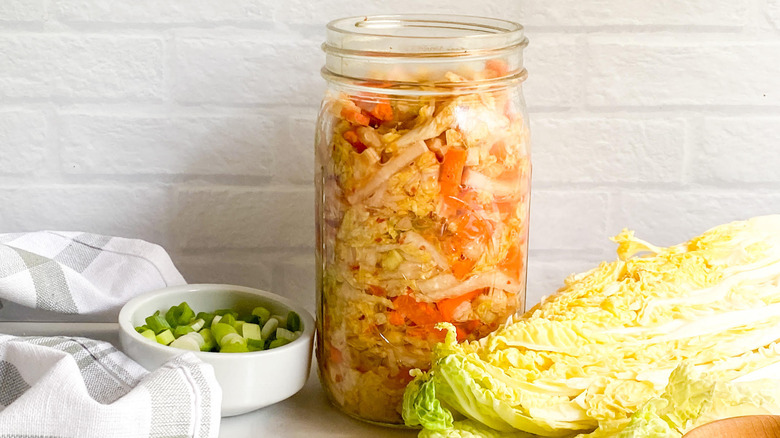
Ingredients
- 1 medium head Napa cabbage
- 3 tablespoons pink Himalayan salt
- 5 cups filtered water
- 2 carrots, cut into matchsticks
- 5 radishes, cut into matchsticks
- 4 scallions, chopped
- 1 tablespoon ginger, grated
- 4 cloves garlic, minced
- 3 tablespoons fish sauce
- 1 tablespoon red pepper flakes
- 1 tablespoon sugar
Directions
- Cut the cabbage in half lengthwise, then again into quarters. Remove the core, then cut it crosswise into thin strips.
- Place the cabbage in a large bowl and add the salt. With a gloved hand, massage the salt into the cabbage so it's fully distributed.
- Cover the cabbage with filtered water and place a plate on top of the vegetable to keep it submerged under the water. Let this sit for an hour
- While the cabbage is sitting, prep the carrots, radishes, scallions, ginger, and garlic.
- In a small bowl, combine the ginger, garlic, fish sauce (or water, if preferred), red pepper flakes, and sugar.
- When the cabbage is ready, drain the water it was in, and rinse it in fresh water. Put it back in the large bowl.
- Add the carrots, radishes, scallions, and sauce. Mix well with a gloved hand to fully combine.
- Add this to a 32-ounce Mason jar. As you fill the jar, press down on the kimchi with a wooden mallet to enable the liquid to rise above the cabbage mixture to remove any air pockets. Continue filling the jar and pressing out the air until you've added all the cabbage and the jar is almost full. You want to maintain a ½-1-inch space at the top empty. There should be a layer of liquid covering the cabbage and rising above it.
- If you have one, place a glass weight (made for this purpose) on top of the kimchi to keep the vegetables below the surface of the liquid. If you don't have a glass weight, use a large piece of cabbage to fold over the mixture to keep it from rising above the water.
- Close the lid tightly. If you don't have a lid designed for fermenting, you can use a wide-mouth plastic lid and leave more empty space at the top to account for escaping gas.
- Let the jar sit on the counter for 3-14 days. Once it's ready to go (taste it to see if you like it before storing in the fridge), store it in the fridge with a lid for up to a month.
Nutrition
| Calories per Serving | 29 |
| Total Fat | 0.2 g |
| Saturated Fat | 0.0 g |
| Trans Fat | 0.0 g |
| Cholesterol | 0.0 mg |
| Total Carbohydrates | 5.8 g |
| Dietary Fiber | 1.5 g |
| Total Sugars | 3.4 g |
| Sodium | 547.4 mg |
| Protein | 1.9 g |
